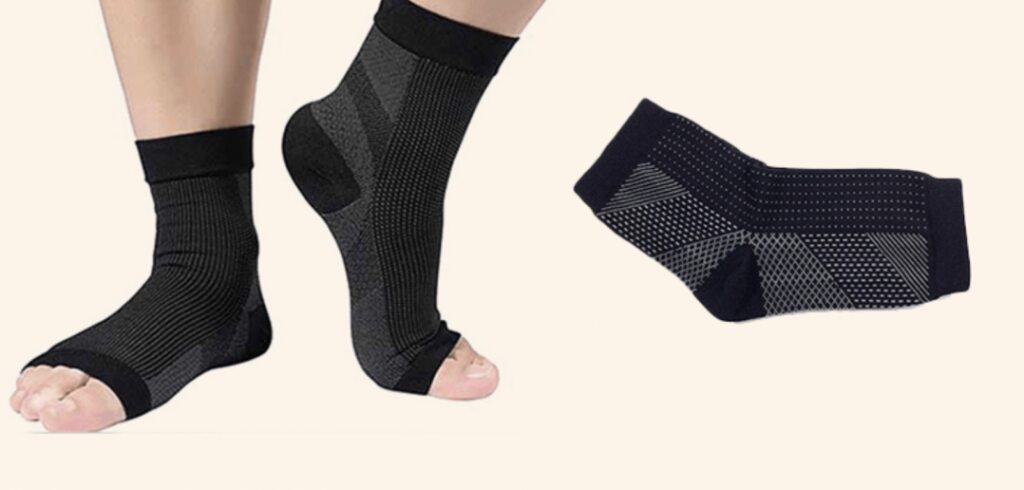One of the quickest and most pervasive ways to lower your quality of life is through pain. Here are some things to know about compression socks and sciatica pain if you experience nerve pain and are wondering if they can help.
Sciatica is a type of pain that starts in your lower back and travels down one leg, into your foot. It is thought to be brought on by spinal bones pressing on a nerve, which may include numbness or muscle weakness. Depending on the severity of the pain and how long it lasts, surgery may be necessary. (MayoClinic).

Role of Compression Socks in Providing Relief From Sciatica Pain
Compression socks offer support and ease sciatica pain in the legs. Additionally, they work well for other bodily problems involving veins and muscle. For instance, doctors frequently advise wearing compression socks for shin splints because they facilitate daily activities.
You can stand and walk without experiencing any pain thanks to compression socks, which is very important for people with sciatica. Compression socks will enable you to go to work and finish other daily tasks.
Compression socks help to alleviate the sciatica symptoms of numbness, weakness, tingling, and other symptoms. They increase the blood circulation in the legs. Because compression socks apply pressure to the appropriate pressure points, the leg pain and swelling also subside.
Not only are compression socks helpful for conditions like shin splints and sciatica They are beneficial if you work long hours sitting down, have back pain, or walk a lot. In general, compression socks are effective for people from all backgrounds.
But it is unquestionably not a good idea to purchase any compression socks from the market!
Which Compression Socks Manages Sciatica Pain Best?
What does copper have to do with compression socks? Let’s go into more detail. Compression socks with copper infusion offer warmth and comfort in addition to copper’s anti-microbial properties. For instance, copper destroys these 6 disease-causing viruses:-.
- Enterobacter aerogenes
- Vancomycin-resistant Enterococcus faecalis (VRE)
- Pseudomonas aeruginosa
- Methicillin-resistant staphylococcus aureus (MRSA)
- Staphylococcus aureus (Staph)
- Escherichia coli O157: H7 (E. coli)
Apart from that, the following unique advantages of copper ions being infused into compression sock yarn:
- Copper compression socks’ improved blood circulation prevents lactic acid build-up. They also give quick relief to tired feet.
- Your feet’s inflammation is reduced by wearing copper socks, which relieves your muscles’ and nerves’ pain.
- By eradicating the bacteria and keeping the feet dry, copper compression socks eliminate the unpleasant odor from your feet.
- In cold weather, the copper ions prevent numbness and pain in your feet by reducing heat loss from your feet.
- Your blood circulation is improved by compression socks, which is beneficial when treating conditions like DVT, varicose veins, oedema, etc.
- Due to their anti-microbial qualities, they prevent conditions like ringworm, yeast infection, and athlete’s foot by killing bacteria, viruses, and fungi.
- By reducing sweat, copper compression socks keep your feet dry and cool. It helps a lot if you live an active lifestyle.
- Your feet’s skin becomes firmer, softer, and healthier as a result of copper’s enhancement of collagen production in the skin.
- Copper compression socks are durable. They can withstand significant wear and tear and are machine washable.
- The best part is that only copper’s natural properties can provide all of these advantages.
To find out why copper compression socks are excellent for treating sciatica and other excruciating conditions, read the ultimate guide to copper compression socks.
Level of Compression Socks
Different levels of compression socks are ideal for preventing various illnesses. For vein issues, 20-30 mmHg graduate compression socks work well. As pain and inflammation worsen, the level of compression increases. Check out the following table for clarity.
Compression Level Medical Level Level of Support Medical Grade 1 8 to 15 mmHg Mild Compression Medical Grade 2 30 to 40 mmHg Extra-firm Compression Medical Grade 3 40 to 50 mmHg Prescription-level Compression
This article does not intend to suggest compression socks as a sciatica treatment. However, they successfully relieve its symptoms to allow you to perform daily tasks like housework and your job.
In addition, specialists advise consulting a physician or a spine specialist whenever you experience sciatica symptoms. Moreover, you should seek medical attention as soon as possible if your pain and symptoms are severe.
- FFP2 / CE Marked
- Four layers of protection
- Filters more than 99% of particulate matter
- Comfortable, washable & eco-friendly
- Destroys 99.99% of viruses
- Ultimate comfort & flexibility
- Washable & Eco-friendly
- Anti-Odour Deowear Zone
- Luxuriously Soft Cotton & Bamboo (Lenzing Viscose)
- 30% Copper fibre throughout the crotch area
- 5% spandex for comfort throughout
- Perfect Fit Waistband
- Natural Anti-Microbial
- Self-Cleansing Properties
- Breathable Compression Fabric & Comfortable
- 8 – 15mmHg of Compression
- Natural Anti-Microbial
- Anti-DVT & Anti-Odour
- Breathable Compression Fabric, Comfortable & Durable
- 8 – 15mmHg of Compression
- Anti-Odour Deowear Zone
- Luxuriously Soft Cotton & Bamboo
- Perfect Fit Waistband
- Natural Anti-Microbial
- Self Cleansing & Hygienic
- Luxuriously Soft Cotton & Bamboo
- Natural Anti-Microbial
- Self Cleansing & Hygienic
- Luxuriously Soft Cotton & Bamboo
- Anti-bacterial & Anti-Fungal
- Breathable fabric for comfort
- Copper is known to promote softer feet
- Natural Anti-Microbial
- Self-Cleansing Properties
- Breathable Compression Fabric & Comfortable
- 8-15mmHg of Compression
FAQ
Why does compression help lower back pain?
Inflammation, which may be one of the causes of lower back pain in women, is lessened by the compression. Additionally, it increases blood flow to the low back, which promotes speedy recovery.
When should you not wear compression socks?
If you have serious heart issues or have leg artery circulation issues, you shouldn’t wear a compression garment. Additionally, it is advised to exercise caution when dealing with diabetic neuropathy and sensory impairments.
Is there a downside to wearing compression socks?
Compression sock use carries some potential risks, as with any therapeutic option. Compression socks can lead to discomfort by feeling extremely tight and uncomfortable at higher pressures. Skin irritation or damage: Tingling, itching, redness, or bruising are symptoms of irritation.
How many hours a day should you wear compression stockings?
When wearing compression stockings, you should remove them before going to bed. Put them on again first thing in the morning. If you’re wearing stockings on both legs, you should receive at least 2 pairs or 2 pairs of stockings. This implies that while the other is being washed and dried, you can wear one pair or one stocking.
7 Reasons You Need Compression Socks. Hint Lebron James Wears Them
Reference:
https://www.copperclothing.com/blogs/post/compression-socks-for-sciatica
https://www.chiro-med.ca/blog/treating-lower-back-pain-compression-hosiery-2
